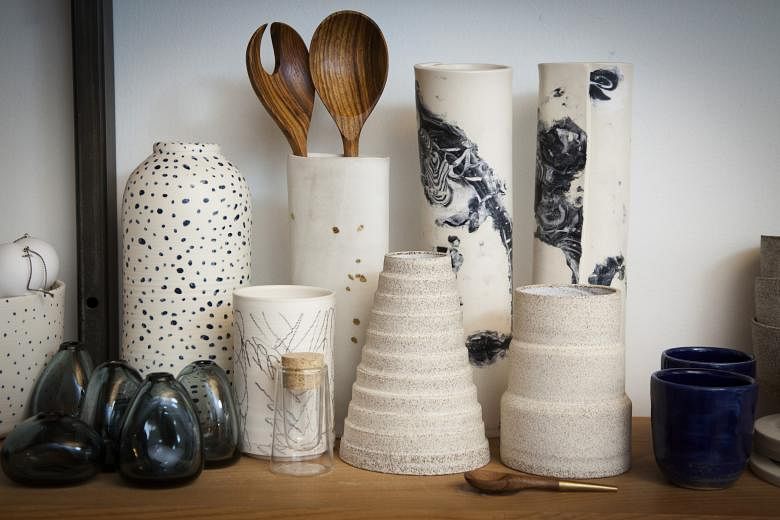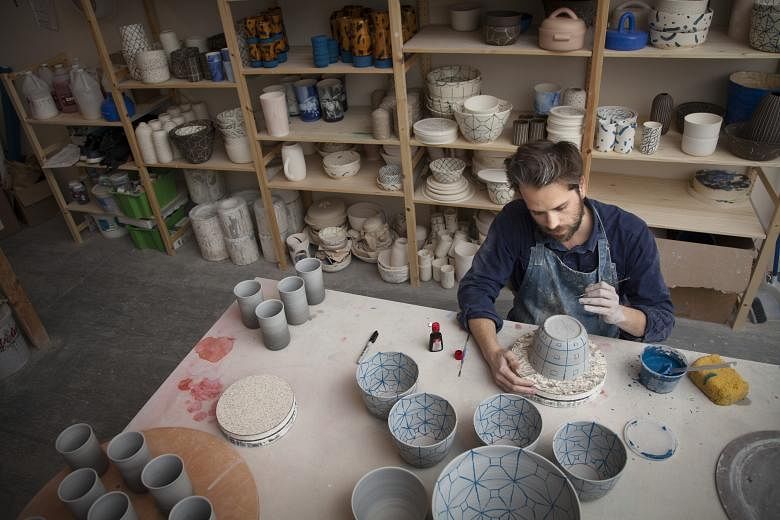NEW YORK • Handcrafted, small- batch ceramics are everywhere these days.
You see them in trendsetting boutiques such as the Primary Essentials in Brooklyn and Still House in Manhattan, artfully arranged in window displays and on shelves like totems of good taste.
They can be spotted in the stylised pages of Kinfolk, Apartamento and other cult magazines, often paired with organically shaped cutting boards and sun- dappled potted succulents. Vogue even devoted two pages in this year's September issue to a new wave of independent ceramists.
And among certain creative- minded millennials, ceramics have replaced jewellery and furniture made from salvaged lumber as the craft du jour, with access to choice kilns as a status symbol to be flaunted on Pinterest and Instagram.

"There is beauty in imperfection and having items that are really handmade," said fashion designer Steven Alan, who populates his boutiques with textural American and Japanese ceramics in neutral hues.
While terrariums, Edison bulb light fixtures and fixed-gear bicycles have all enjoyed moments of demarcating cool, handcrafted small-batch ceramics are suddenly the accessory of the moment.
Just as those earlier trends represented a tactile, down-to-earth counterbalance to today's sped-up, technology-centred world, the rejection of factory-produced sameness in dinnerware and vases reflects a desire to get back to something more essential.
People want to know where their free-range eggs come from and where their coffee beans are grown and roasted. They also want the vessels they use to consume those things to embody a deeper story about craftsmanship and creativity.
Mr Robert Sullivan, contributing editor at Vogue, who wrote the magazine's ceramics article, said that ceramics are popular now because they are "among the most obviously and literally handmade things".
"It's an antidote to all the electronics," he added.
Ms Julie Carlson, editor-in-chief of design website Remodelista, has chronicled this rise. "It's entwined with the farm-to-table movement," she said. "It's this desire to know the origin of what's in your kitchen."
In Brooklyn and Queens, there is no shortage of makeshift pottery studios, clay-throwing classes and boutiques that resemble the home page of e-commerce website Etsy.
The launchpad for many New York potters has been Choplet, a ceramics studio and teaching space that French-born Nadeige Choplet opened with her husband, John Lego, in Williamsburg in 2005.
"When I started, I had four wheels and I was only giving two or three classes a week," Ms Choplet said. But the space grew into a buzzing clay-making hub with more than 30 wheels along with a separate studio called the Williamsburg Ceramic Center.
The giant of the new ceramics movement is Heath Ceramics in Sausalito, California.
In 2003, husband-and-wife designers Robin Petravic and Catherine Bailey bought and restarted the company, which was originally founded in 1948 to produce mid-century modern housewares.
The couple edited the collections of dinnerware, decorative objects and tile, and introduced new pieces and artist collaborations while maintaining a focus on handcrafted production.
Along the way, they turned Heath from a niche company, which did about US$1 million in sales in 2003, to a globally known outfit with 200 employees that sells about US$20 million (S$28.2 million) in products a year. In October, it received a National Design Award from the Cooper Hewitt, Smithsonian Design Museum.
But like a lot of emerging potters, the couple say one of the original reasons they were attracted to ceramics was that it allowed them to oversee the design process from start to finish.
"The nice thing about clay is that you can do it all and it doesn't take a lot of resources to build it up," Mr Petravic said.
"You can't buy a forge to make metal things. But clay and a wheel, or a mould and a kiln, is pretty straightforward."
NEW YORK TIMES


